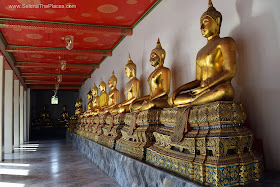Wat Pho dates back to the 17th century and is also one of the earliest public centers of education in Thailand. As one of Bangkok's oldest temples, it has been rebuilt, renovated and enlarged over the years. There is so much to see here.
As we entered the large complex we stopped to throw some fortune sticks. A cup of sticks is shaken until one falls out. The number on the stick guides you to a paper with a fortune on it. There is also incense, candles, drums and gongs.
As this is a place of worship, there is calm, quiet presence. Everyone speaking in hushed tones. In one of the chapels we found the Reclining Buddha. This is one of the largest Buddha statues in Thailand. It is 150 feet long and 50 feet tall, covered in gold leaf. It's as if the temple was built around it, encasing the elegant reclining figure.
The various poses and postures (Asanas) of Buddha statues are very specific, each representing a specific period in the life of Buddha. There are different Mudras or hand gestures with various meanings. The Reclining Buddha shows him lying on his right side, resting his head on his hand. It represents his last minutes on earth before entering into nirvana.
The statue is well known for the feet which are inlaid with Mother of Pearl. Unfortunately, they were covered as work was being done. If you are planning to visit, be sure to do some research on the proper etiquette for visiting a Buddhist temple. For instance, you should dress appropriately and remove your shoes. Here is a good place to start your research on Thailand Temple Etiquette.
At the end of the great hall, we purchased a bowl of coins. For good luck, we walked along the wall dropping a coin, one each into 108 bronze bowls. The soft clink of the coin and the repetition of the act was so calming. With each one I thought the name of a loved one. It's a very special place.
This is my new motto in life. "Please only travel."
Wat Pho, formally know as Wat Phra Chetuphon Vimolmangklararm Rajwaramahaviharn is also the birthplace of traditional Thai massage and medicine. It is still taught and practiced here. We didn't have time to have a massage, but this would be the place to do so.
Many of the walls in the compound are decorated with diagrams and inscriptions of the pressure points on the body that are used in traditional Thai massage.
Wat Pho contains 91 chedis or stupas. These are mound-like structures built to house relics or remains. They are covered in colorful ceramic tiles in intricate designs. They are a place for Buddhist to meditate.
There are over 1,000 Buddhist statues at Wat Pho, the largest collection in Thailand.
The asana that we saw the most was this sitting posture with the left hand in the lap and the right hand touching the earth. It represents the moment of Buddha's enlightenment and "calling the earth to witness." If you'd like to read more about the images of Buddha, here is an interesting article from the V&A Museum.
Looking at these photos and writing about Thailand has been wonderful. It takes me right back there. What a fascinating place. I want to go back now!! I hope you don't mind but I still have quite a few blog posts to publish about our time there. There's just so much that I don't want to forget.
Are you planning a trip to Thailand? What is on your agenda?
























No comments:
Post a Comment
Thanks for commenting. I love to hear from you!